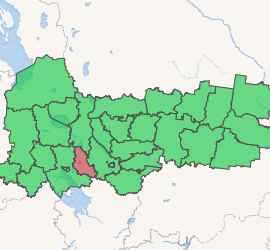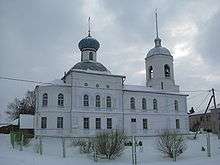Sheksninsky District
Sheksninsky District (Russian: Шексни́нский райо́н) is an administrative[1] and municipal[8] district (raion), one of the twenty-six in Vologda Oblast, Russia. It is located in the center of the oblast and borders with Kirillovsky District in the north, Vologodsky District in the east, Poshekhonsky District of Yaroslavl Oblast in the south, and with Cherepovetsky District in the west. The area of the district is 2,500 square kilometers (970 sq mi).[4] Its administrative center is the urban locality (a work settlement) of Sheksna.[3] Population: 33,375 (2010 Census);[5] 36,007 (2002 Census);[10] 34,679 (1989 Census).[11] The population of Sheksna accounts for 62.8% of the district's total population.[5]
Sheksninsky District Шекснинский район | |
|---|---|
.png) Flag .png) Coat of arms | |

Location of Sheksninsky District in Vologda Oblast | |
| Coordinates: 59°13′N 38°30′E | |
| Country | Russia |
| Federal subject | Vologda Oblast[1] |
| Established | January 12, 1965[2] |
| Administrative center | Sheksna[3] |
| Area | |
| • Total | 2,500 km2 (1,000 sq mi) |
| Population | |
| • Total | 33,375 |
| • Estimate (2018)[6] | 33,445 (+0.2%) |
| • Density | 13/km2 (35/sq mi) |
| • Urban | 67.1% |
| • Rural | 32.9% |
| Administrative structure | |
| • Administrative divisions | 2 Urban-type settlements, 15 Selsoviets |
| • Inhabited localities[3] | 2 Urban-type settlements[7], 374 Rural localities |
| Municipal structure | |
| • Municipally incorporated as | Sheksninsky Municipal District[8] |
| • Municipal divisions[8] | 2 Urban settlements, 13 Rural settlements |
| Time zone | UTC+3 (MSK |
| OKTMO ID | 19658000 |
| Website | http://www.sheksnainfo.ru |
Geography
Sheksninsky District is located on both banks of the Sheksna River, with the western (right-bank) part being considerably smaller than the eastern (left-bank) one. The Sheksna was turned into the Sheksna Reservoir upstream of the settlement of Sheksna, and downstream of that settlement it flows its natural course. A major part of the district belongs to the basin of the Sheksna, with the exception of its southeastern corner, which is divided between the basins of the Sogozha and the Vologda Rivers. As the Vologda belongs to the basin of the Northern Dvina, and both the Sheksna and the Sogozha belong to the basin of the Volga, the district is crossed by the divide between the basins of the White and the Caspian Seas.
The landscape of the district is flat, with large areas allocated for agriculture. The remaining territory is covered by woods.
History
The Sheksna River was always one of the main waterways connecting central Russia with Lake Onega and with the Northern Dvina. The selo of Nikolskoye, currently the work settlement of Sheksna, has been known since 1590.
In the course of the administrative reform carried out in 1708 by Peter the Great, the east of the current area of the district was included into Archangelgorod Governorate. In 1780, Arkhangelogorod Governorate was abolished and transformed into Vologda Viceroyalty, and in 1796 the latter was split into Arkhangelsk and Vologda Governorates. What is now Sheksninsky District was then a part of Vologodsky Uyezd of Vologda Governorate.
On July 15, 1929, several governorates, including Vologda Governorate, were merged into Northern Krai, and the uyezds were abolished. Instead, Chyobsarsky District with the administrative center in the railway station of Chyobsara (which is now an urban-type settlement) was established as a part of Vologda Okrug. In 1936, Northern Krai was transformed into Northern Oblast. In 1937, Northern Oblast was split into Arkhangelsk Oblast and Vologda Oblast. Chyobsarsky District remained in Vologda Oblast.[2]
The western part of the area was in 1708 included into Ingermanland Governorate (known since 1710 as Saint Petersburg Governorate). In 1727, separate Novgorod Governorate was split off. The area became a part of Ustyuzhensky Uyezd of Belozersk Oblast of Novgorod Governorate. In 1776, the area was transferred to Novgorod Viceroyalty. In 1777, Cherepovetsky Uyezd was established, and the area was transferred to it. In 1796, the viceroyalty was abolished, and the area was transferred to Novgorod Governorate. Cherepovetsky Uyezd was abolished and merged into Ustyuzhensky Uyezd. However, in 1802 Cherepovetsky Uyezd was re-established.
In June 1918, five uyezds of Novgorod Governorate, including Cherepovetsky Uyezd, were split off to form Cherepovets Governorate, with the administrative center in Cherepovets. On August 1, 1927, Cherepovets Governorate was abolished, and its area became Cherepovets Okrug of Leningrad Oblast. Simultaneously, the uyezds were abolished, and Prisheksninsky District with the administrative center of Nikolskoye (currently Sheksna) was established. On September 23, 1937, Prisheksninsky District was transferred to newly established Vologda Oblast.[2]
In 1954, the selo of Nikolskoye, the administrative center of Prisheksninsky District, was granted urban-type settlement status and renamed Sheksna. In 1959, Prisheksninsky District was abolished and merged with Chyobsarsky District. On December 13, 1962, as a part of an abortive Khrushchev's administrative reform, Chyobsarsky District was abolished as well and split between Vologodsky and Cherepovetsky Districts.
On January 12, 1965, Sheksninsky District with the administrative center in Sheksna was established.[2]
Economy
Industry
The economy of the district is based on food industry and timber industry. [12] The Sheksna Hydropower Plant, located in Sheksna, is a major energy producer.
Agriculture
Agriculture in the district is based on production of meat, milk, and eggs.[12]
Transportation
A114 highway, connecting Vologda to Cherepovets and St. Petersburg, crosses the district from east to west, passing Sheksna. There are also local roads.
The railroad connecting Vologda with Cherepovets and St. Petersburg also crosses the district from east to west. There are railway stations in both Sheksna and Chyobsara.
The Sheksna is navigable within the district and is a part of the Volga–Baltic Waterway (formerly known as the Mariinsk Canal System), which connects the Rybinsk Reservoir in the basin of the Volga River and Lake Onega in the basin of the Neva.
Culture and recreation

The only museum in the district is the Historical and Cultural Center, located in Sheksna. It displays collections on local history, as well as temporary exhibitions.[13]
References
Notes
- Law #371-OZ
- Справка об изменениях административно-территориального устройства и сети партийных и комсомольских органов на территории Вологодской области (1917-1991) (in Russian). Архивы России. Retrieved November 21, 2011.
- Resolution #178
- Судаков, Г. В. (2006). Г. В. Судаков (ed.). Вологодская энциклопедия (PDF) (in Russian). Вологда: ВГПУ, Русь. p. 541. ISBN 5-87822-305-8. Retrieved November 23, 2011.
- Russian Federal State Statistics Service (2011). "Всероссийская перепись населения 2010 года. Том 1" [2010 All-Russian Population Census, vol. 1]. Всероссийская перепись населения 2010 года [2010 All-Russia Population Census] (in Russian). Federal State Statistics Service.
- "26. Численность постоянного населения Российской Федерации по муниципальным образованиям на 1 января 2018 года". Federal State Statistics Service. Retrieved January 23, 2019.
- The count of urban-type settlements may include the work settlements, the resort settlements, the suburban (dacha) settlements, as well as urban-type settlements proper.
- Law #1130-OZ
- "Об исчислении времени". Официальный интернет-портал правовой информации (in Russian). June 3, 2011. Retrieved January 19, 2019.
- Russian Federal State Statistics Service (May 21, 2004). "Численность населения России, субъектов Российской Федерации в составе федеральных округов, районов, городских поселений, сельских населённых пунктов – районных центров и сельских населённых пунктов с населением 3 тысячи и более человек" [Population of Russia, Its Federal Districts, Federal Subjects, Districts, Urban Localities, Rural Localities—Administrative Centers, and Rural Localities with Population of Over 3,000] (XLS). Всероссийская перепись населения 2002 года [All-Russia Population Census of 2002] (in Russian).
- "Всесоюзная перепись населения 1989 г. Численность наличного населения союзных и автономных республик, автономных областей и округов, краёв, областей, районов, городских поселений и сёл-райцентров" [All Union Population Census of 1989: Present Population of Union and Autonomous Republics, Autonomous Oblasts and Okrugs, Krais, Oblasts, Districts, Urban Settlements, and Villages Serving as District Administrative Centers]. Всесоюзная перепись населения 1989 года [All-Union Population Census of 1989] (in Russian). Институт демографии Национального исследовательского университета: Высшая школа экономики [Institute of Demography at the National Research University: Higher School of Economics]. 1989 – via Demoscope Weekly.
- "Общая характеристика района" (in Russian). Администрация Шекснинского муниципального района. Retrieved November 22, 2011.
- "Центр истории и культуры" (in Russian). Администрация Шекснинского муниципального района. Retrieved November 22, 2011.
Sources
- Законодательное Собрание Вологодской области. Закон №371-ОЗ от 4 июня 1999 г. «О вопросах административно-территориального устройства Вологодской области», в ред. Закона №2916-ОЗ от 7 декабря 2012 г. «О внесении изменений в Закон области "О вопросах административно-территориального устройства Вологодской области"». Вступил в силу со дня официального опубликования. Опубликован: "Красный Север", №124–125, 29 июля 1999 г. (Legislative Assembly of Vologda Oblast. Law #371-OZ of June 4, 1999 On the Matters of the Administrative-Territorial Structure of Vologda Oblast, as amended by the Law #2916-OZ of December 7, 2012 On Amending the Oblast Law "On the Matters of the Administrative-Territorial Structure of Vologda Oblast". Effective as of the day of the official publication.).
- Правительство Вологодской области. Постановление №178 от 1 марта 2010 г. «Об утверждении реестра административно-территориальных единиц Вологодской области», в ред. Постановления №686 от 25 июня 2012 г. «О внесении изменений в некоторые Постановления Правительства области». Вступил в силу 20 марта 2010 г. Опубликован: "Красный Север", №29, 20 марта 2010 г. (Government of Vologda Oblast. Resolution #178 of March 1, 2010 On Adopting the Registry of the Administrative-Territorial Units of Vologda Oblast, as amended by the Resolution #686 of June 25, 2012 On Amending Various Resolutions of the Oblast Government. Effective as of March 20, 2010.).
- Законодательное Собрание Вологодской области. Закон №1130-ОЗ от 6 декабря 2004 г. «Об установлении границ Шекснинского муниципального района, границах и статусе муниципальных образований, входящих в его состав», в ред. Закона №2809-ОЗ от 5 июля 2012 г. «О внесении изменений в отдельные Законы области, устанавливающие границы и статус муниципальных образований области». Вступил в силу через 10 дней со дня официального опубликования. Опубликован: "Красный Север", №242, 11 декабря 2004 г. (Legislative Assembly of Vologda Oblast. Law #1130-OZ of December 6, 2004 On Establishing the Borders of Sheksninsky Municipal District, on the Borders and Status of the Municipal Formations Comprising It, as amended by the Law #2809-OZ of July 5, 2012 On Amending Various Laws of the Oblast, Establishing the Borders and the Status of the Municipal Formations of the Oblast. Effective as of after 10 days from the day of the official publication.).